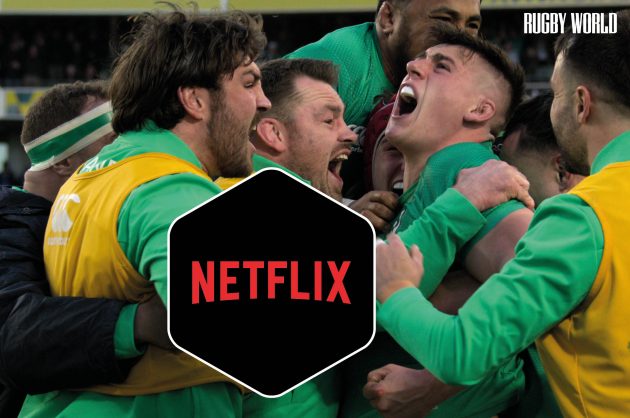If there is a series two, will we get more insight into the rugby side and team dynamics?
Early on in Six Nations: Full Contact, Scotland head coach Gregor Townsend describes rugby as “the ultimate team game”. The makers of this access-all-areas Netflix documentary clearly didn’t get the memo, because this eight-part series is much more interested in individuals than the collective. It’s still the story of 30 men running into each other at high speed, of course, but by keeping the focus so tight, it often loses sight of the sport’s unique mix of beauty, brains, brutality and teamwork.
But preaching to the converted isn’t really the point of the exercise. Full Contact comes from the makers of the extremely popular Formula 1: Drive to Survive, and the Six Nations organisers are clearly hoping the new doc has a similar impact on rugby’s international profile – especially as there’s no tournament more marketable than the annual battle for northern hemisphere supremacy.
Related: How to watch Full Contact
Unsurprisingly, Full Contact is rugby union through a Hollywood lens. With its cinematic, ground-level camera angles, fast cuts and slo-mo, the on-field action plays out like a US sports movie. Even so, there’s no question the broader nuances of the game are lost in translation – even delivered as a high-octane highlights package, scenes from that Dublin encounter between Ireland and France can’t match watching the action live.

England prop Ellis Genge is a candid and engaging interviewee in Full Contact. (Netflix)
But Full Contact’s biggest selling point is the chance to see players and coaches outside the pressure cooker of a packed stadium. Luckily, the producers did their homework, and identified some engaging stars to front the show. From Ellis Genge’s opening up about his “imposter syndrome” to Andrew Porter’s frank discussions on mental health, the talking head interviews frequently reveal the human side of the players. Meanwhile, Sebastian Negri and Stuart Hogg shine a light on the heavy toll rugby takes on the body – Hogg’s struggles with a battered body come with added poignancy following his retirement last summer.
And yet it’s the less stage-managed moments that really stick in the memory: Finn Russell shaping his backline on the training ground, Porter belting out a song after receiving his 50th cap, or Shaun Edwards giving team talks in heavily accented French. You also see enough Budgy Smugglers to last a lifetime!
Full Contact review – could we have seen more?
Not that access always equates to insight. Sure, you get front-row seats for loads of pep talks and team announcements, but the really juicy stuff – the bust-ups, the tactics, the post-match parties – is clearly languishing somewhere on a cutting room floor (if the makers actually got to see any of that). Even when Russell and Townsend address their well-publicised past disagreements, it’s in a heavily sanitised, PR-friendly way.
Then again, Full Contact is only reality in the loosest sense of the world, the mere presence of cameras enough to radically alter behaviours. It never rings true when family members ask their partner/son obviously scripted questions, while too much time is spent trying to shape narratives that don’t really exist – the rivalry between former youth team-mates Louis Rees-Zammit and Stephen Varney is massively overplayed. It feels like a major misstep, especially when the most important ongoing storyline – the race for the title – is something of an afterthought.

Stuart Hogg’s struggles with his battered body come to the fore (Netflix)
Indeed, our biggest takeaway in this Full Contact review is that the series as a whole struggles to convey what makes the Six Nations such a big deal. Full Contact is littered with shots of passionate fans, and overblown soundbites like “the rivalry is colossal”, but it skirts over the tournament’s history and position within the game. The show fails to hammer home that England versus Scotland is the oldest fixture of them all, or that the Rugby World Cup was looming large over the 2023 Six Nations. And despite valiant efforts to explain the potential player strike that threatened to derail Wales’ match against England, the dispute makes little sense if you don’t know the labyrinthine backstory of the Welsh game.
That’s arguably the heart of Full Contact’s problems. For most of its runtime it’s trapped on the halfway line, unsure whether it wants to appeal to existing fans or bring new audiences to the party. It subsequently struggles to deliver on either count.
If the show comes close to replicating Drive to Survive’s success in spreading the sporting gospel, then job done. But in trying to distil a team game into a story of individuals, Full Contact has missed an easy kick in front of the posts.
Six Nations: Full Contact is available now – here’s how to watch the show on Netflix. If you’re in the mood for more behind-the-scenes rugby action, Premiership documentary Mud, Sweat and Tears is available now on Prime Video. Let us know what you make of our Full Contact review on social media.
Download the digital edition of Rugby World straight to your tablet or subscribe to the print edition to get the magazine delivered to your door.






